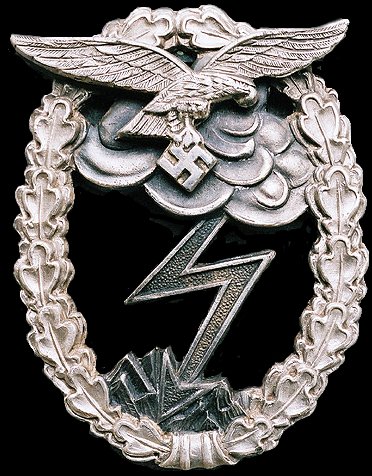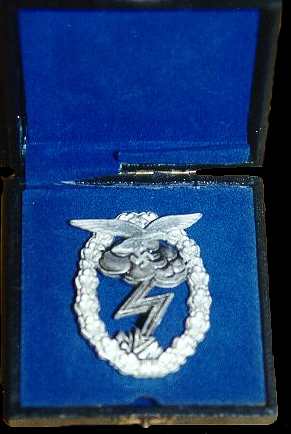
by Jacques Calero
The Luftwaffe Ground Assault Badge was designed by Professor von Weech of Berlin and instituted by Hermann Goring on March 31, 1942 to honor Air Force personnel that took part in ground military actions. Individuals who were previously awarded the General Assault Badge, Infantry Assault Badge or the Tank Assault Badge, exchanged them for this badge at this point.
Manufacturing and Technical information
The Ground Assault Badge consists of a Luftwaffe eagle flying above a storm cloud, which generates a lightening bolt that strikes rough ground. In most cases, the Luftwaffe eagle is a separate, stamped nickel piece and is riveted on top of an eagles’ outline on the badge. This can either be done by three domed rivets, two domed rivets, or one flush rivet. On some late war badges, the eagle is cast as an integral part of the badge itself, with no need for a separate piece. The eagles' wings protrude outside the wreath of oak leaves that surrounds it. These badges were produced with both silver and darkened wreaths
At the base of the badge there is a tie which has on each side a single half oak leaf rising into the seven bunches of three oak leaves that make up the wreath. The bunches end tip to tip at the badges apex. The wreath is separated from the storm cloud by three voided areas located on each side and above the cloud.
The badge measures 56mm by 43mm and the width of the wreath varies between 7 and 7.5mm. The eagle has a wingspan of 41.5mm and the height of the eagle including the swastika is 21mm.


Photo above - Mark Miller Collection
The reverse of the badge is flat and can carry a variety of hinges. There are three separate types. The first is a conventional hinge that is let into the back of the badge and then has a piece of the badge turned over at each end. It usually has a broad bellied pin. The second type consists of a conventional hinge, which is soldered directly onto the badge. The third has a hinge that has the integral hook cast in the badge during manufacture. The second and third type, have needle pins held by a shepherds hook attachment, or a barrel attachment, which includes a “C” shaped hook attached to the badge by a plate, or recessed into the badge.
Presentation, Wear and DocumentsThe Luftwaffe Ground Assault Badge was awarded in either a black leatherette box with a silk liner and blue velvet base, or a paper packet. An authorizing document was presented with it, and the proper annotations were made in the soldiers’ Wehrpass and Soldbuch. As with most Wehrmacht War Badges, the decoration was worn on the left side of the uniform. Award CriteriaThe award was presented to Luftwaffe field divisions who were engaged in combat along side their comrades in the land armed forces. There were twenty-two fully equipped Luftwaffe field divisions, among them the famed and elite “Herman Goring” division, who were under the direct command of the Goring himself until July of 1944. The Divisions were controversial as many in the Wehrmacht command thought them a drain of precious resources that could have been better utilized if employed in the ever retreating Heer forces. Even though there were skeptics, it must be stated that the better trained Luftwaffe divisions gave a good account of themselves in land combat alongside their brothers at arms. |
 |
In order to receive the Ground Combat Badge, the following criteria needed to meet,
- Involvement in three separate engagements on separate days.
- Being wounded in an engagement.
- Being awarded a decoration in an engagement.
- A member killed in an action was automatically awarded the badge.
Paratroopers and assault gunners could also receive this award provided they met the above criteria.
Luftwaffe Assault Badge 25, 50, 75 and 100 Class
As the war continued, a need to decorate the Luftwaffe ground aces arose and on November 11, 1944, the Luftwaffe numbered badges were introduced. These badges were slightly larger and included a box at the base of the badge with the number that represented the number of attacks the recipient has participated in. Paratrooper and gun assault units could also receive the number badges if they meet the criteria. Due to its late institution these badges are extremely rare, in fact there is debate as to whether or not they were ever actually presented.
![]()
© Copyright Wehrmacht-Awards.com LLC |